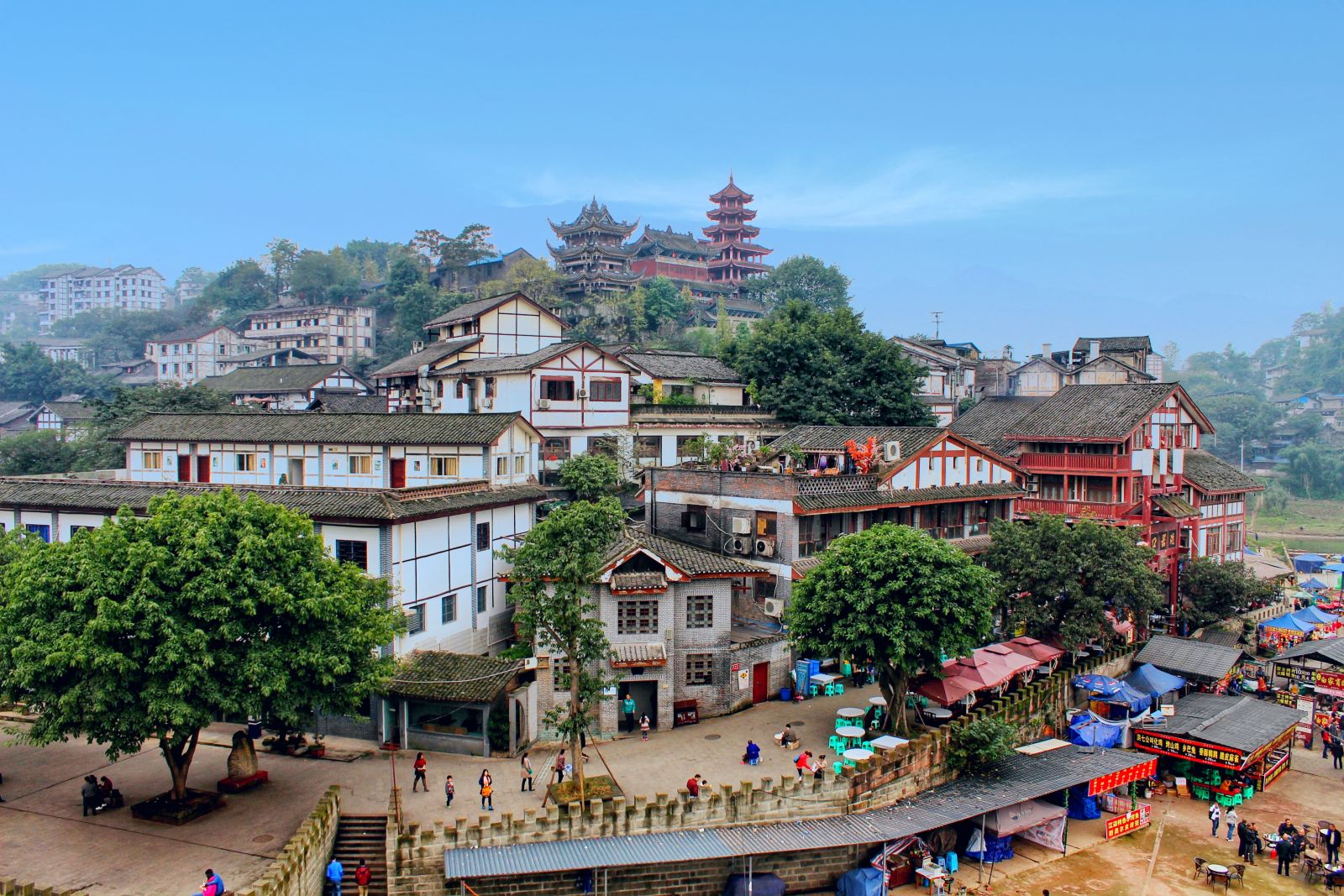Chinese Name: 磁器口古镇 Pronunciation: cí qì kǒu gǔ zhèn
Area: It covers an area of 1.5km².
Best Visiting Time: In spring and autumn
Suggested Visiting Hours: 3-6 Hours
Admission Ticket Fare: The Ciqikou Ancient Town is free to enter.
Opening Hours: The Ciqikou Ancient Town is open for 24 hours.
Address: Ciqikou Ancient Town is located in Shapingba District of Chongqing and it is situated on the bank of Jialing River.
Popular Activities: Experience traditional performances such as Sichuan opera and taste various traditional snacks in teahouses. The temple fair held in the Spring Festival every year is the most distinctive traditional activity, attracting tens of thousands of citizens to participate in it.
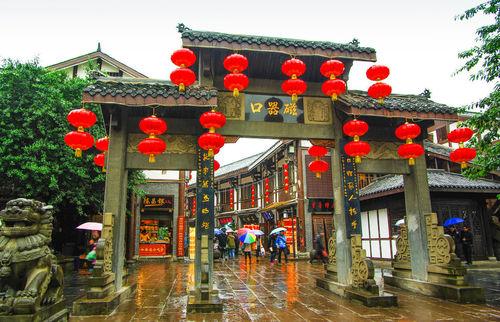
The Ciqikou Ancient Town in Chongqing is a traditional ancient town protected and conserved by the government and a famous historical and cultural zone in China. Ciqikou is located at the bank of Jialing River, Shapingba District, Chongqing. It is the closest ancient town landscape to the main urban area of Chongqing. The unique geomorphology of the Ciqikou has formed a natural harbour and is an important land and water and land dock along the Jialing River. Built in the Song Dynasty, it is the epitome and symbol of the ancient city of Chongqing. Ciqikou is a national AAAA- level scenic spot. And it was elected as one of the top ten Landmarks of the Cultural and Tourism Industry in Chengdu and Chongqing" on November 18, 2020. More than 3 million people from home and abroad visit it every year.
The Ciqikou, which has a history of 1200 years, is known as the first ancient town in Chongqing and has preserved a relatively complete ancient architecture. Most of the buildings along the street are in the architectural style of the Ming and Qing Dynasties, which attract countless people every year. There are 12 alleys in the Ciqikou Ancient Town. The ground is paved with slabstone. Most of the slabstone on the main streets were brought from the Jialing River and the oldest ones were more than a hundred years old. There are numerous shops on both sides of the alleys.
Every year, Ciqikou Ancient Town will organize many activities about cultural inheritance in traditional festivals. During the Spring Festival, activity of writing Spring Festival couplets will be held on-site. At Tomb-Sweeping Day, visitors can enjoy tea and watch Sichuan Opera performances. At the Dragon Boat Festival, citizens and foreign friends will make zongzi which is a traditional Chinese food and drink yellow rice wine to feel the charm of traditional history and culture. At the Mid-Autumn Festival and National Day, there also are activities to visit the historical sites of the ancient town. Through the success of a number of activities, the thousand-year-old Ciqikou Ancient Town, as a "microcosm of Chongqing", makes the local traditional history and culture effectively inherited, manifested and carried forward.
The Ciqikou Ancient Town dates back to the Song Dynasty. The earliest name of it was the White Rock Field.
During the Ming Dynasty, the emperor Zhu Yunwen once hid in the Baolun Temple on the White Rock Mountain. In Chinese history, the dragon symbolizes the emperor. So, after discovering this, people changed the name from the Baolun Temple to the Long Yin Temple. Because in Chinese long means dragon, Yin means hide. And the White Rock Field was also renamed Longyin Town.
In the early Qing Dynasty, porcelain became the main industry of Longyin Town. In 1918, porcelain local merchants and gentry pooled their money to create a new craft porcelain factory in the old town. Later, the variety of porcelain increased, and its reputation expanded because of the progress and improvements in manufacturing porcelain. There were more than 70 factories in the ancient town when the porcelain industry was at its peak.
During the period of the Republic of China, Chongqing became the secondary capital. Because of the convenience of water transportation, the ancient town became a distribution place for agricultural and side products of various states along the middle and upper reaches of the Jialing River. Some merchants in the city set up branch stores in the town to purchase goods and export cotton yarn, cloth, kerosene, salt, sugar, foreign general goods, daily necessities, hardware, soil bowls, paper, and special tobacco.
At the beginning of the 20th century, Liu Xiang, the governor of Sichuan, went to the Ciqikou Ancient Town and opened a steel mill and a mechanic shop, making it the earliest steel-making base in Sichuan.
Since New China was founded in 1949, Ciqikou Ancient Town is still bustling. From morning till night there are numerous businessmen and tourists on the Ancient Pier. It is known as "Little Chongqing".
In 1958, the Ancient Pier was moved to Hanyu Road. Therefore, the function of the Ciqikou Ancient Town as a distribution centre and transfer station for land and water wharfs gradually disappeared. In order to preserve this rich historical and cultural relic, the government repaired and restored the architecture with the style of the Ming and Qing Dynasties. Therefore, the Ciqikou Ancient Town was developed into a block scenic spot with folk culture.
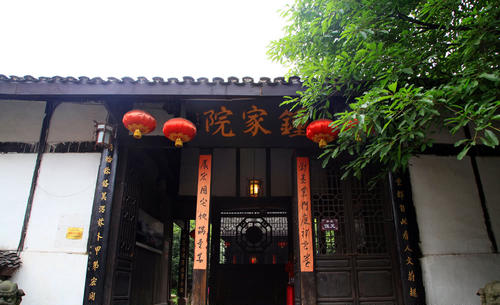
Built around 1890, the compound of the Zhong family has a history of more than 130 years. Mr. Zhong Yunting, the master of the house, was an official of the Empress Dowager Ci Xi. After he retired and returned to his hometown, he designed and built this compound in the Ciqikou Ancient Town.
The architectural style of the compound is very distinctive. In terms of spatial layout, the compound embodies the northern style, but in terms of building materials and structure, it embodies the southern characteristics. For example, the north uses tube tiles to build roof tiles, while the south uses board tiles. There are several chairs placed in the compound. In the middle of summer, people could enjoy tea and conversations about anything in it, leaving worries behind.
The compound of the Zhong family originally covered an area of about 2,000 square meters, but it was destroyed during the Anti-Japanese War, leaving a front yard of 500 square meters.

Han Lin is the name of an official position in ancient China. The Han Lin Academy is an ancient private school preserved in the main urban area of Chongqing. During the reign of Emperor Qianlong of the Qing Dynasty (1736-1795), there was a private school called "Lishi Cottage" of the Sun family in the Ciqikou Ancient Town. And then it was called "Lishi school" by the common people. In the late Qing Dynasty, three people of the Sun family passed the imperial examinations at the provincial level. They all became Han Lin. At the same time, Huang Zhongyin who studied here was a successful candidate in the highest imperial examinations. He was first a Han Lin. And then he served as the Academy officer to monitor the imperial history. Duan Dazhang, another student, also was a successful candidate in the highest imperial examinations, and he also became a Han Lin. Therefore, the local people also called the schoolhouse the " The Han Lin Academy ".
Therefore, the Academician Courtyard is the place that the students yearned for at that time. Later, Huang Zhongyin inherited the private Academician Courtyard. And it has been handed down from generation to generation by the Huang family. There is a small worship platform in the inner courtyard, which was the place where the owner held family worship.
Because hidden in the depths of the roadway, it is especially quiet. Therefore, the Academician Courtyard is a suitable place to concentrate on reading. The academician courtyard retains many features of traditional dwellings, such as long eaves, square patios, and carved doors, which are still intact and charming. Now it has become a small teahouse where people brew a pot of fragrant tea.

The Baolun Temple was built in the Western Wei Dynasty, formerly known as the White Cliff Temple. It was said that the emperor of the Ming Dynasty once lived in seclusion here. The " Mahavira Hall" in the existing temple was inscribed by Zhao Puchu, the former president of the Buddhist Association of China. The Temple is vigorous, and it can be called a treasure of China's architectural art.
Baolun Temple is related to Zhu Yunwen, emperor of the Ming Dynasty. It is said that the emperor disguised himself as a monk and fled south. After arriving at the Ciqikou Ancient Town, he had lived in seclusion in the temple for several years. One day, he got sick. He saw many doctors and was not cured. He was very distressed. Suddenly one day he had a dream. The immortal in the dream told him that a boy's urine could cure you. When the emperor woke up, he went to find the boy's urine. After he drank it, he was cured of his illness. Therefore, the boy’s urine is known as "the water to protect the dragon (emperor) ". In order to commemorate Emperor’s seclusion here, a statue of a boy urinating was carved near Baolun Temple.
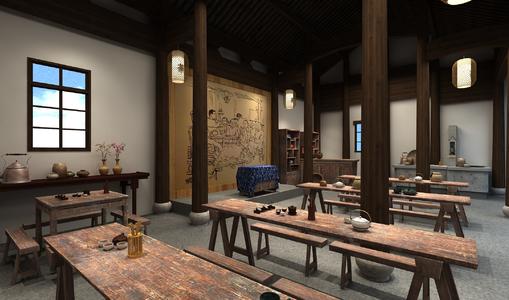
Teahouse is a place to enjoy tea and folk art. Here people enjoy a chat or gather with friends. There are many varieties of opera such as Sichuan Opera in Teahouse. The teahouse is always filled with people. It offers the opportunity for people to become acquainted with the unique folk opera.
The Ancient Pier was located along the Jialing River during the Ming and Qing Dynasties. It flourished in the Ming and Qing Dynasties. This is the only old wharf in the main urban area of Chongqing. The Ancient Pier is one of the most important memories of Chongqing. The Ciqikou Ancient Town has been an important commodity distribution centre in eastern Sichuan since ancient times, with flourishing trade. During the Republic of China period, it achieved unprecedented prosperity, and numerous celebrities gathered there.

Nine stone Jars river beach is located in the Jialing River, the legend of Zhang Xianzhong, the late Ming peasant uprising leader, who broke into Chongqing originates from here. Stone tools of the Neolithic Age were left on the riverbank. In 1939, Central University excavated the cliff tombs of the Han Dynasty beside the riverbank. Some inscriptions were on the walls of the tombs. At the same time, some clay figures and pottery were unearthed.

Wenchang Palace is a sacred place. At the gate of Wenchang Palace, there is a statue of Emperor Zhu Yunwen of the Ming Dynasty. It is said that once there were as many as 100 rooms in the Wenchang Palace, which can be seen on the other side of the Jialing River. It is a pity that the Wenchang Palace was affected by the war in the 1930s, leaving only the present gate site.
Jinbi Bridge is the oldest and larger-scale ancient bridge in the Ciqikou Ancient Town. It was built in the Qing Dynasty and connected Zheng Street and Jinbi Street. During the period of the Republic of China, busy markets were on both ends of the bridge.
Baoshan Palace was a famous Taoist temple in the Ciqikou Ancient Town. It is a place for believers to pray for good fortune. During the Anti-Japanese War, it was transformed into Jialing Experimental Primary School affiliated to Sichuan Provincial Education Institute. From 1942 to 1946, Mr. Ding Zhaozhong, the winner of the Nobel Prize in Physics, studied here. Because he once studied in primary school here, we set up the exhibition hall. There are some old photos in it. If you are interested in the old photos, you can have a look.

Now, the palace has been transformed into a very distinctive teahouse. The most distinctive feature is that the place is noticeably quiet though it is in the noisy area. A moment ago, we were in a busy city. But once we were inside the palace, we could hardly hear the sound outside. It seems kind of magical. Actually, the building materials of the palace make it this way. In ancient times, when building houses, people usually settled the gate on the central axis. But this door is not in the centre of the central axis, so the sound from the outside world cannot enter the palace directly. At the same time, the wall of the Palace is also solid and thick, which has a good effect on sound insulation.
There is a big tree in it, which almost fills the whole courtyard. The tree is 50 or 60 years old and grows luxuriantly. It is extremely comfortable to sit under the tree. You can drink tea quietly or watch a lively local opera.

It is a street where people sell Chongqing snacks and local specialties. Like other commercial streets, there are also a lot of goods for sale such as ornaments in the Ciqikou Ancient Town. Sichuan is recognized as the best place to make spicy food. Even compared with food from Sichuan Province, Chongqing cuisine scores high in spiciness. Chongqing cuisine is exceptional and very worth trying. Local dishes include Hotpot, Chongqing-Style Boiled Blood Curd, and Chongqing noodles. All come very highly recommended.
The second floor of the shops on both sides of the streets are also lined with many small bars, many of which have only appeared in recent years. It is wonderfully comfortable to order a pot of wine and listen to a folk song.
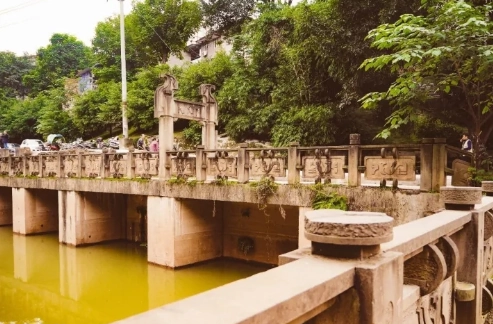
During the Ming Dynasty, Emperor Zhu Yunwen was usurped from the throne by his fourth uncle Zhu Di. After escaping from the imperial palace, he shaved his hair and became a monk. When he went to Chongqing, he hid in Baolun Temple. After discovering the story that the emperor once lived in seclusion here, people changed the name from Baolun Temple to Longyin Temple. And the White Rock Field was also renamed Longyin Town.
During the Anti-Japanese War, the Provincial Institute of Education set up a school in the Ciqikou Ancient Town. Wu Mi who was a master of Chinese traditional studies taught here. Apart from teaching and writing books, he also occasionally went to the teahouse in the centre of the town to taste the tea and learn about the situation of people and society. Ding Zhaozhong who is a winner of the Nobel Prize in physics studied at Jialing Primary School in the Ciqikou Ancient Town.
The Yard of the Zhong Family→The Academician Courtyard→Good Treasure Palace→The Cizheng Street→The Baolun Temple→The Wenchang Palace→The Ancient Pier
The Ciqikou ancient town is located in the subtropical inland area in the northern hemisphere, belonging to the subtropical monsoon climate. The most pleasant seasons of the year are spring and autumn. Tourists should avoid visiting the Ciqikou Ancient Town at noon in summer because outdoor temperatures can reach more than 40 degrees in summer. Therefore, Chongqing is known as the "furnace".
Chongqing Railway Station: Take bus 503 and get off at the station of Ciqikou West. It takes fifty minutes.
Take bus 808 and get off at the station of Tongjiaqiao. And then you need a 5-minute walk to the destination.
Chongqing West Railway Station: Take touring bus T033 and get off at the station of the Ciqikou. It takes thirty minutes.
Take bus 202 and get off at the station of Ciqikou West. It takes one hour and thirty minutes.
Chongqing Jiangbei International Airport: Take Airport Express Bus No. K07 and get off at the station of Tongjiaqiao. And then you need a 6-minute walk to the destination.
Chongqing Railway Station: Take Subway Line and get off at Ciqikou Station.
Chinese: 请带我去磁器口。English: Please take me to the Ciqikou Ancient Town
If you go to the Ciqikou Ancient Town from Chongqing Railway Station, it takes about 20 minutes (about 24 yuan).
If you go to the Ciqikou Ancient Town from Chongqing West Railway Station, it takes about 30 minutes (about 26 yuan).
If you go to the Ciqikou Ancient Town from Chongqing North Railway Station, it takes about 23 minutes (about 30 yuan).
If you go to the Ciqikou Ancient Town from Chongqing Jiangbei International Airport, it takes about 30 minutes (about 53 yuan).
If you go to the Ciqikou Ancient Town from Hilton Chongqing, it takes about 27 minutes (about 27 yuan).
